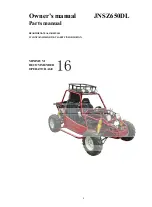
SLF 2250/4000
Hydromatic Stinger
Page - 57 -
© 2014
Operating the Pump System
ATTENTION !
The pressure indicated at the manometer (P28) must not exceed 16
bar !
The pressure indicated at the manovacuummeter (P30) must not
drop below 2 bar, otherwise the supply hose will collapse and
restrict water flow.
The priming pump must not be engaged - that means that the pump
pressure should exceed 2 bar, otherwise the priming pump will not
be disengaged by the water pressure.
A priming process can be disengaged by pressing switch (S3).
When operating the pump system, let the drive engine idle to
conserve power and pressurized air supply.
Before connecting a hose to the hydrant, open the hydrant valve to
allow discharge, until clean water flows out of the hydrant.
CAUTION !
Do not operate the pump with closed pressure outlets - dangerous
increase of temperature will result!
Water and foam compounds are conducting electricity!
Remain a safe distance from electricity conductors!
Some materials will increase in volume and/or weight when mixed
with water.
Because of the possibility of chemical reactions, some materials
must not come into contact with water!
FAILURE TO FOLLOW THIS PROCEDURE COULD CAUSE
PERSONAL INJURY!
When the flow of water through the fire hose or pipe is suddenly
stopped, the resulting surge is referred to as "water hammer".
Water hammer can often be heard as a distinct, sharp clank, very
much like a hammer striking a pipe. This sudden stoppage results
in a change in the direction of energy and this energy is instanta-
neously multiplied many times. These excessive pressures can
cause considerable damage to water mains, plumbing, fire hoses,
and fire pumps.
Nozzle controls, hydrants, and valves should be operated slowly to
prevent water hammer.
- Before opening a handline discharge valve make sure that the
nozzles are held tightly - danger of water hammer effect!
- Release pressure before disconnecting a hose!
- Use nozzles for fire fighting purposes only.
- Never aim the jet at people.
P30 P28
















































